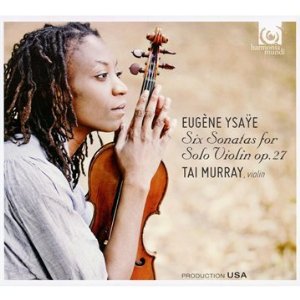Violinist Tai Murray can legitimately boast just a third-degree separation from the composer of these solo violin sonatas: one of her teachers, Yuval Yaron, was a student of Josef Gingold, who in turn was a student of Eugène Ysaÿe. Yaron’s own recording of these six sonatas, from 1990 (Accord), is a hard-to-find but still sought-after reference for these works, shaped and colored with Yaron’s many personal expressive touches—in some instances more extreme in dynamics or tempo than Murray’s—yet always respecting the composer’s score and performance style. (Yaron has made enough of a mark as a teacher to have inspired a joke or two from his students, one of which, told to me a few years ago by the mother of one such student at Indiana University: “Oh, yes,” she said, when I mentioned the name of her daughter’s teacher, “when you’re a student of Yuval Yaron, you’re on your own.” Cute—and I’m sure not entirely true; but irresistible nonetheless.)
Either Murray was in no way left “on her own”, or she was just such a naturally gifted, self-motivated, and determined artist that she was going to thrive and blossom regardless of her teacher or the demands of study, practice, and the inherent challenges of playing the most difficult instrument ever invented. I believe it was more of the latter, made more certain by the fact that at age 10 she decided all on her own to devote everything to the violin.
As we expect from first-rank violinists these days, her technique is impeccable, and if nothing else, these works require mastery of everything in the virtuoso’s book of bowing and fingering skills. But unlike Bach’s works in this genre (which were the inspiration for Ysaÿe’s), these are less about achieving the magical illusion of polyphony while maintaining the preeminence of melody and harmonic relationships than they are about exploiting the violin’s single-line voice and technical range. Ultimately, these are “artist” pieces, more intellectually intriguing to the violinist than they are likely to be emotionally involving for the listener. Which is not to diminish their value and impressive qualities as virtuoso concert works.
Not every young violinist would be ready for this music, but Murray clearly is a thoughtful interpreter—a quality that often eludes a 30-year-old performer—and she shows an admirable understanding of structure and context, exemplified in the opening Grave of the Sonata No. 1. The double-stops are not “effects” but are solidly integrated into the texture and thematic movement, so we easily follow a line without losing its harmonic anchors. In the most Bach-like movement, the Fugato, we clearly hear the interaction between the voices, and Murray holds nothing back dramatically at the movement’s conclusion. Throughout Murray is mindful of the expressive character of each sonata—each is dedicated to a different violinist—while she revels in the technical and thematic devices that bring these “characters” to life, including snatches of Bach’s E minor partita, a sul ponticello passage, the rich, deep tone of the Fourth sonata (à Fritz Kreisler), or the left-hand pizzicato and colorful use of double-stops in the Sonata No. 5.
We also can be grateful for the excellent engineering—the recording was made in the ideal and justifiably revered acoustics of New York’s American Academy of Arts and Letters—which faithfully captures the boldness and brilliance of Murray’s 1690 Tononi violin. Highly recommended—the modern reference for these works.
































